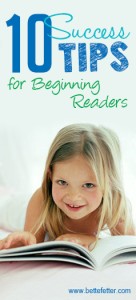10 Tips to Make Your Child a Better Reader
 As parents we know reading is important. We know our kids need to read well, to do well at school. We also know how difficult it can be for any child when they are beginning to read. But how do we help our visual kids make the transition from picture books to words, build skill and confidence, all while keeping their love of books intact?
As parents we know reading is important. We know our kids need to read well, to do well at school. We also know how difficult it can be for any child when they are beginning to read. But how do we help our visual kids make the transition from picture books to words, build skill and confidence, all while keeping their love of books intact?
Visual kids love picture books. They love being read to. They love the time spent hearing stories, seeing pictures and imagining new things. But, when it’s time for them to read on their own, it means a lot less pictures and a lot more words. While we know this is going to be good in the long run, it can be a struggle to get them there. Without some extra help, reading can become one more thing our visual kids struggle with at school – and it can become a big negative at home.
Here are 10 things you can do at home to help your visual child read:
- Read. Read. Read. – First, help your child develop a love and affection for books at a young age. Read to your child. Make it special. Do it often. Have lots of books in the house. Make regular trips to the library. Talk about books. Tell stories. Enjoy the characters. The more your young child enjoys books – the more they’ll want to read on their own.
- Keep reading – Learning to read can be a slow and laborious process, especially for visual kids. As you make time for them to read to you, be sure you keep reading to them. Time spent reading to them keeps their love of books alive, but also helps them recognize words they’re learning and builds vocabulary and comprehension skills.
- Be read to – Beginning readers need to practice reading at home. Make time for them to read to you. Make it a positive experience. Don’t do it when they’re tired, frustrated or overwhelmed. Eliminate distractions. Make it fun. Position them for success.
- Not just any book – While there’s an art to picking the books you read to your child; finding the right books for your child to read is even more critical. Find out what books they’re reading at school. Head to the library. Use their resources to find books that match your child’s interests and reading level. Have a good assortment of reading books at home, with higher level readers ready as their reading skills increase.
- Learn sight words – Visual kids learn words by seeing them. They are better at remembering whole words, instead of phonics. ‘Sight words’ are perfect words for your early reader to practice ‘remembering’ because they’re the words they’ll see the most when they read.
- Practice. Practice. Practice. Morning, afternoon and evening – practice reading appropriate sight words. Small, frequent bursts of reading sight words will help build confidence and fluency. Make word cards. Practice them with your child, a few at a time, flashcard style. Mix it up. Keep it light. Do it often. Make it fun. Check out my sight words practice video for more tips.
- Write sight words – When your early reader is learning to write, they can practice writing their sight words. Writing words helps kids remember them and also helps develop handwriting skills. How many words and how often do they write them? It’s important not to overwhelm. Plan your writing practice to correspond with what’s happening in the classroom. Download our writing paper to use at home.
- Read more – As your child gets more comfortable reading, you’ll notice increased speed and fluency. As he moves on to ‘harder’ books, more words on a page, continue to carefully match any new books to his reading level. This is also a good time to gradually increase the amount of time he spends reading to you.
- Keep it POSITIVE ! – Learning to read is a lot of work and requires a lot of effort from child, parent and teacher. Our visual kids may be putting in lots more effort than other kids and need the most support and encouragement. Keep it positive!! If you’re exhausted or having a stressful day, ask someone else in family to step in or take the day off. Do what you need to do to keep reading fun for everyone involved.
- Read everything – Reading is not just about books. It’s not just for the classroom. Encourage your reader to read everything from cereal boxes and road signs, to directions on the iPad or computer. Once you’ve built a strong foundation and they have a taste of success – the sky’s the limit!
Learning to read is a REALLY big deal. Appreciate what it has taken for your child to master such a complex and meaningful skill and appreciate all you’ve done to help them. Becoming comfortable and competent in the world of words is especially significant for visual learners. The time and extra effort you have invested will impact them in ways too profound to measure.











Summer Reading | Reading Statistics | Bette Fetter
September 26, 2019 @ 12:21 pm
[…] are some great ways to encourage reading, especially for our visual learners. But, the best way to encourage reading is to do it yourself, […]